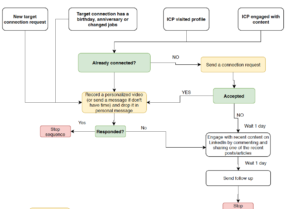
Cold emails, cold calls, and cold messaging are dead. How many times have you heard it? If you believe these channels are indeed dead, then all marketing channels are. The real problem is how cold outreach works today. Scrape the contacts. Set up automation. Spam them all. Pray that somebody will reply. Rinse and repeat.
Let’s be clear: this is not an outreach; it’s spam. And this approach is dead. To have success with cold outreach, you should:
- Be very clear who your ideal customer profile (ICP) is, the buying committee structure, and how they typically buy products like yours
- Warm-up and engage the entire buying committee
- Leverage intent data to seize the moment and reach out at the right time to the right people
- Master social selling
- Personalise your outreach
In this article, I’ll skip the ICP part assuming you have it, and share with you practical examples of warming-up programmes, social selling and personalised outreach.
Start with warming up a buying committee before the outreach
People buy from people they know, like, and trust. When I discuss this inevitable law of marketing with my clients’ marketers or SDRs, they always nod their heads in agreement. My next question usually makes them numb:
If you know and accept this, why don’t you warm up and build a relationship with your target accounts before reaching out to them?
Here is a step by step guide:
Connect on LinkedIn with the entire buying committee (or on another channel they hang out), engage with their content, and start conversations
First, connect with the champion, and give a “value-add,” not just a generic connection. Try to set up a call to learn more and see how you can help them. Help deliver more value and build a real relationship, don’t just sell them.
When the relationship is built, connect with the decision-maker. Here is an example. Now the key persons inside your target organisation are aware of you and your product. You built trust and relationship, and once there is a need, you’ll be the first company they look to. Of course, like any relationship, this one needs to be nurtured.
Also Read: 5 email outreach tips to aid your startup marketing efforts
Invite your prospects for an interview (podcast, YouTube, or use their quotes in a blog post)
On this step you kill two birds with one stone. Here’s why:
You deliver value up front by giving a PR to your target account.
You build a relationship and learn more about the goals and needs of your target job role.
You analyse if there is a match between your product and their needs. You introduce your product and ask your prospect if they know anybody in their network who might be interested so you can get priceless intros. I learned the process from James Carbary.
Warm up your target accounts with targeted ads on Facebook and LinkedIn
If you have a spare budget, add your target accounts to one of your custom audiences on LinkedIn and Facebook, and retarget them with your best top-of-funnel (TOFU) content and bottom-of-funnel (BOFU) content
Involve target accounts into discussions on social media.
If you regularly post content on LinkedIn, tag your accounts in the posts that might be relevant to them or dm them with a link to the post asking for their opinion.
Host a warm up virtual event
Before making an outreach, try to run an event where you can introduce (not pitch) your product and make your audience aware of the way you solve their challenges. You can manually invite your target accounts. Here is how.
Leverage intent data to reach out at the right moment
To significantly improve your outreach campaigns’ positive reply rate, you need to leverage intent data and set up outreach triggers.
Here are the three most efficient ways to use the intent data:
IP-identification
IP-identification software (like Albacross or Leadfeeder) demonstrates to you what web pages your target accounts viewed, how much time they spent on your website and on what stage of the buying journey they are.
By knowing this, you can adopt outreach strategy with the right CTA:
- Share case studies or articles for those that are at the awareness stage, and ask if that is helpful. Try to establish a relationship, and ask: why were you searching for this article or product?
- Share comparison reports, webinars, market research, or case studies for those who are considering alternatives.
- Share case studies and suggest a free consultation to those on the decision-making stage. Usually, these are the people who visited your product/service page several times and spent some decent time on it.
Here’s an example of an outreach trigger you can set up:
If a company visited your product page several times and spent 30 minutes on your website, it is a good signal they are doing research and might be interested in chatting with you.
Also Read: How to increase at least 15 per cent ROI by running a successful email outreach campaign
When the criteria are met, you can connect with a target job role on LinkedIn or another channel, and follow-up by email. Here is a practical example.

Manual research
Intent data is not limited to just website visitors. Multiple vendors (like Bombora) can help you identify what topics your target accounts are looking for. You can also perform manual research.
To do this, analyse your target account’s product roadmap, check their press releases, or read/listen to their executives’ interviews about strategic goals and initiatives.
Once you see the match between their goals and your product, it’s an excellent time to reach out with a personalized proposal.
Engagement with your team’s or company’s updates
This last one is my favourite.
When the buying committee members of your target accounts engage with your updates on LinkedIn or other social media, this is a perfect trigger to open a conversation, define the challenges, current state, and find a match.
The good news is you don’t need a big network, hundreds of likes and comments, or thousands of views of your posts to generate leads. All you need is creating a simple document and map out all the questions your target accounts have at different stages of the customer journey.
Also Read: These 6 actionable lead management tips can accelerate your ROI
The next steps are straightforward:
- Connect with the entire buying committee
- Engage with their updates by commenting and sending private messages
- Post answers to their questions as posts, tag them in the comments, and share your posts via private messages asking their opinion
When they engage with your content, you have endless opportunities to start the conversation.
Here is a typical process we use with our clients:
One caveat: don’t focus on the vanity metrics such as likes, views, or comments. Your key metrics are:
# of sales conversations your teams started
# of inbound inquiries
The outreach based on intent data shouldn’t be a straightforward pitch. Your goal is to open a conversation. Otherwise, your outreach continues to be a “game of numbers.”
In conclusion
Cold outreach is not dead. What is dead is how many B2B companies are doing it: spamming or cold calling anyone who could be interested in your product.
To get maximum results from the outreach campaigns, you need to:
- Create your ideal customer profile, understand their buying journey from the research to team consideration, figure out the questions, concerns, and doubts they have at different stages
- Warm up your target accounts before the outreach
- Leverage intent data to do a timely and highly personalised outreach. Your call to action should be aligned with the buyer’s journey stage of your prospect.
Your goal is starting the conversation and learning more about your target account needs, and if there’s a match, suggest a call to talk about possible collaboration.
–
Editor’s note: e27 aims to foster thought leadership by publishing contributions from the community. Become a thought leader in the community and share your opinions or ideas and earn a byline by submitting a post.
Join our e27 Telegram group, FB community or like the e27 Facebook page
Image credit: Kaleidico on Unsplash
The post Outreach strategy: How to run sales campaigns that get results and don’t burn your leads appeared first on e27.

